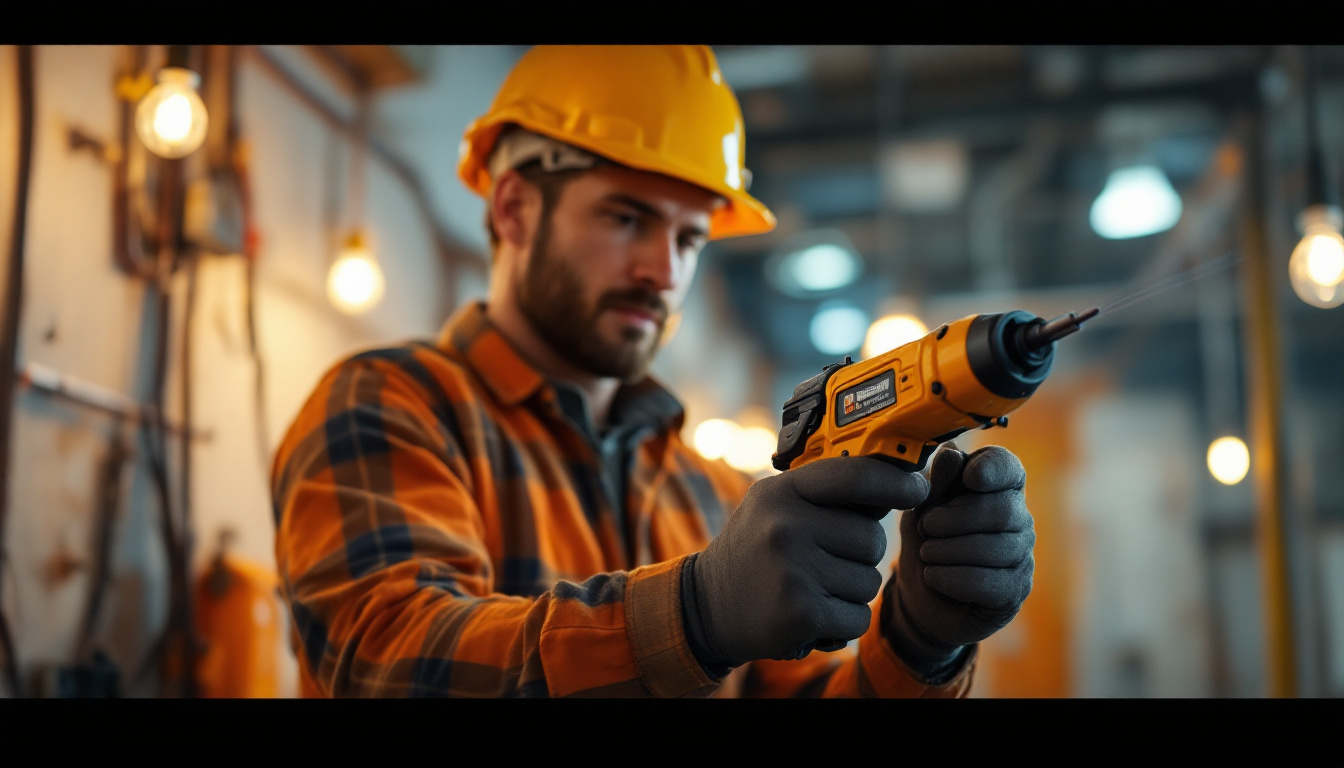
In the world of electrical installations, efficiency and safety are paramount. For lighting contractors, the task of pulling wires can often be a labor-intensive and time-consuming process. This is where electric wire pullers come into play. These tools not only streamline the process but also enhance productivity and reduce the risk of injury. This guide aims to provide comprehensive insights into electric wire pullers, covering everything from their types and benefits to tips on usage and maintenance.
Electric wire pullers, also known as wire pulling machines, are specialized tools designed to assist in the installation of electrical wiring. They are particularly beneficial in large-scale projects where long runs of cable need to be installed in a timely manner. The mechanics behind these devices allow for the smooth and efficient pulling of wire through conduits, reducing the physical strain on workers. By utilizing electric wire pullers, contractors can significantly enhance productivity, ensuring that projects stay on schedule while minimizing the risk of injury associated with manual wire pulling.
Electric wire pullers operate using a motorized system that generates the necessary force to pull wire through conduits. The device typically consists of a spool that holds the wire and a pulling mechanism that can be adjusted based on the weight and type of wire being used. The operator controls the puller, ensuring that the wire is fed smoothly without kinks or twists. This precision is crucial, as any misalignment can lead to damage to the wire or the conduit, potentially causing costly delays and repairs.
Most electric wire pullers come equipped with features such as adjustable speed settings and overload protection, which enhance their usability and safety. Understanding these basic mechanics is crucial for lighting contractors as it allows for better selection and operation of the tool based on specific project requirements. Additionally, many modern electric wire pullers incorporate advanced technology, such as digital displays and remote controls, which further streamline the process and provide real-time feedback on the pulling force and speed.
Electric wire pullers come in various types, each designed for specific applications. The primary distinctions are based on their size, power source, and intended use. Here are some common types:
In addition to these types, some electric wire pullers are designed with specific features tailored to unique tasks. For instance, some models may include integrated cable guides to prevent tangling, while others might have enhanced braking systems for better control during operation. Understanding the variety of options available can help contractors choose the right tool for their specific needs, ultimately leading to more efficient and successful installations.
The advantages of using electric wire pullers extend beyond mere convenience. For lighting contractors, these tools can significantly impact project efficiency and overall quality of work.
One of the most significant benefits of electric wire pullers is the speed at which they can complete tasks. By automating the wire pulling process, contractors can save valuable time, allowing them to focus on other critical aspects of the installation. This efficiency is particularly beneficial in large projects where multiple runs of wire need to be installed simultaneously.
Manual wire pulling can pose several risks, including physical strain and injury. Electric wire pullers minimize these risks by reducing the amount of manual labor required. With a machine doing the heavy lifting, contractors can avoid common injuries associated with repetitive motion and heavy lifting, promoting a safer work environment.
Using an electric wire puller can lead to a more consistent and high-quality installation. These tools help ensure that wires are pulled evenly and without kinks or twists, which can compromise the integrity of the wiring system. A well-executed installation not only meets safety standards but also enhances the longevity of the electrical system.
Selecting the appropriate electric wire puller for a specific job is crucial for maximizing efficiency and effectiveness. Several factors should be considered when making this decision.
Before choosing a wire puller, it is essential to assess the specific requirements of the project. Consider the type and weight of the wire to be pulled, the length of the run, and the environment in which the installation will take place. For instance, a heavy-duty puller may be necessary for large commercial projects, while a portable model might suffice for smaller residential jobs.
Another critical factor is the power source of the puller. Electric models require access to a power outlet, while battery-powered options offer greater flexibility in remote locations. Understanding the job site’s power availability can help in making the right choice.
Consider the weight and portability of the electric wire puller. For contractors who frequently move between job sites, a lightweight and easily transportable model can save time and effort. Conversely, if the puller will remain in a fixed location, weight may be less of a concern.
Once the right electric wire puller is selected, understanding how to operate it effectively is crucial for achieving optimal results. Proper operation not only enhances efficiency but also ensures safety during the installation process.
Before beginning the wire pulling process, it is essential to set up the puller correctly. This involves securing the machine in a stable position, ensuring that the wire is properly threaded through the pulling mechanism, and adjusting any settings based on the weight and type of wire. Taking the time to set up the puller properly can prevent issues during operation.
During operation, it is crucial to monitor the pulling process closely. Watch for any signs of resistance or strain, as these can indicate potential problems such as kinks in the wire or obstacles in the conduit. Adjusting the speed or stopping the puller to address issues can save time and prevent damage to the wire.
After completing the wire pulling, it is essential to perform post-operation checks. Inspect the wire for any damage and ensure that it has been installed correctly. Additionally, clean and maintain the electric wire puller according to the manufacturer’s instructions to prolong its lifespan and ensure optimal performance for future projects.
After each use, it is essential to clean the electric wire puller. Remove any debris, dust, or residue that may have accumulated during operation. A clean machine not only operates more efficiently but also reduces the risk of damage over time.
Regularly inspect the components of the wire puller, including the motor, pulling mechanism, and electrical connections. Look for signs of wear or damage, such as frayed wires or loose connections. Addressing these issues promptly can prevent more significant problems down the line.
Always refer to the manufacturer’s guidelines for maintenance and care. Each model may have specific requirements for upkeep, and adhering to these recommendations can ensure optimal performance and safety. Keeping a maintenance log can also help track any repairs or servicing that may be needed.
Safety should always be a top priority when using electric wire pullers. Understanding and adhering to safety protocols can prevent accidents and injuries on the job site.
Wearing appropriate personal protective equipment is essential when operating electric wire pullers. This may include safety glasses, gloves, and steel-toed boots. PPE helps protect against potential hazards associated with electrical installations.
Contractors should have a solid understanding of electrical safety principles. This includes knowledge of how to work safely around live wires and the importance of using properly rated equipment. Familiarity with local electrical codes and regulations is also critical for ensuring compliance and safety.
Investing in training and certification for all team members can enhance safety on the job site. Proper training ensures that everyone understands how to operate electric wire pullers safely and effectively, reducing the risk of accidents and injuries.
Electric wire pullers are invaluable tools for lighting contractors, offering increased efficiency, safety, and quality in electrical installations. By understanding the various types of pullers, selecting the right model for specific projects, and adhering to proper operating and maintenance practices, contractors can enhance their productivity and ensure successful outcomes.
As the electrical industry continues to evolve, staying informed about the latest tools and techniques is essential. Embracing technology such as electric wire pullers not only streamlines operations but also positions contractors for success in a competitive market. With the right knowledge and equipment, lighting contractors can tackle even the most challenging projects with confidence.
Ready to elevate your electrical projects with the best tools in the trade? Look no further than LumenWholesale for all your lighting needs. Our extensive selection of high-quality, spec-grade lighting products comes at unbeatable wholesale prices, ensuring you get the most value for your investment. Say goodbye to local distributor markups and hello to superior products, free shipping, and the convenience of hassle-free bulk buying. Don’t compromise on quality or price. Visit LumenWholesale today and experience the perfect blend of quality, affordability, and convenience for your next project.
Discover the latest trends in small closet light fixtures that every lighting contractor should be aware of.

Discover the advantages and drawbacks of outdoor motion sensing light bulbs for lighting contractors.

Discover the pivotal role exterior work lights play for lighting contractors in enhancing safety, efficiency, and project quality.

Illuminate your home’s exterior with confidence using our comprehensive lighting contractors’ checklist for front yard light poles.